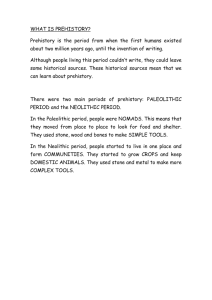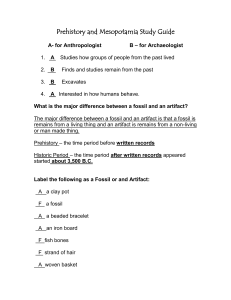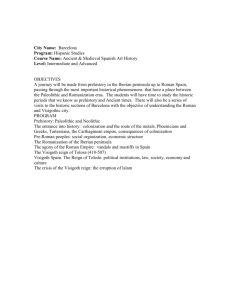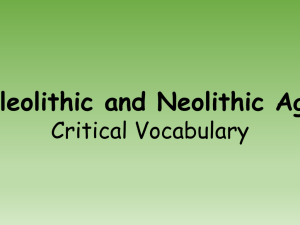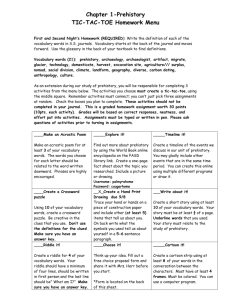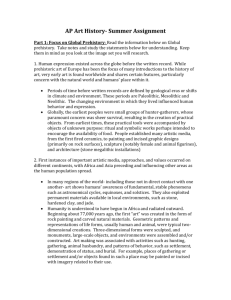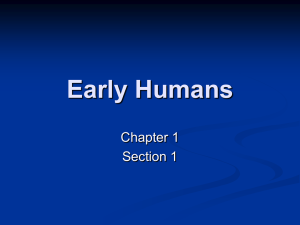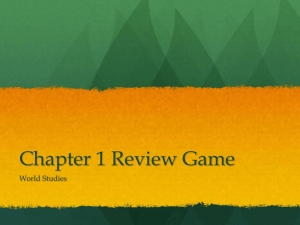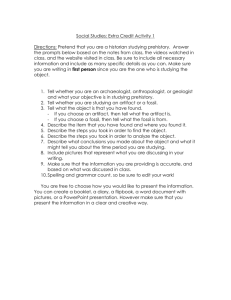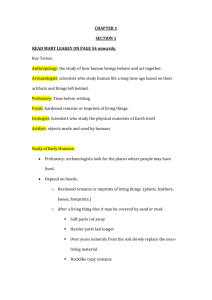Prehistory Notes
advertisement
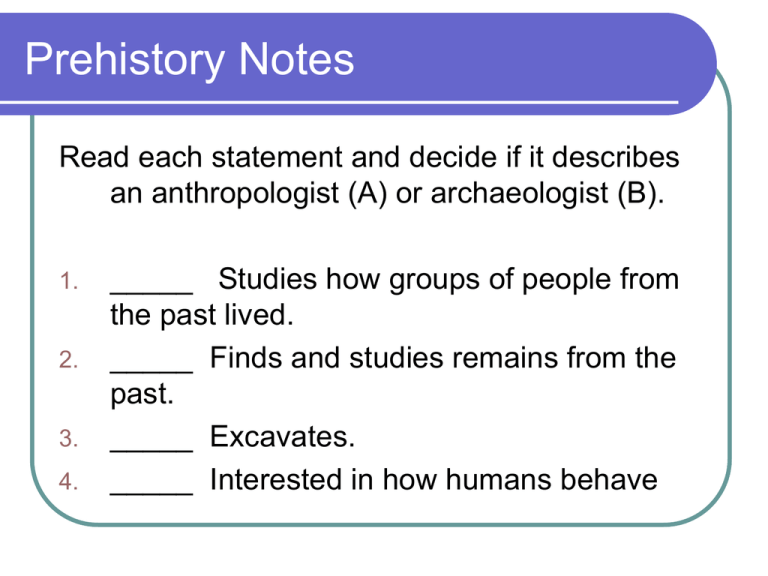
Prehistory Notes Read each statement and decide if it describes an anthropologist (A) or archaeologist (B). 1. 2. 3. 4. _____ Studies how groups of people from the past lived. _____ Finds and studies remains from the past. _____ Excavates. _____ Interested in how humans behave Prehistory Notes What is the major difference between a fossil and an artifact? _______________________________________ _____________________________________ ____________________________________ Prehistory- the time period before _________. Historic Period- ________________________ _____________________________________ Prehistory Notes Label the following as a Fossil or Artifact: _____ _____ _____ _____ _____ _____ _____ a clay pot a feather a beaded bracelet an iron sword fish bones strand of hair woven basket The Paleolithic Age What were nomads? ________________ __________________________________ __________________________________ Why did people have to live this way during the Stone Age? ________________________________ ________________________________ ________________________________ The Paleolithic Age Tell why each change was important: Advanced tools and Weapons (2 reasons) 1. ___________________________________ 2. ___________________________________ Language (2 reasons) 1. ___________________________________ 2. ___________________________________ The Paleolithic Age Tell why this change was important: Discovery of Fire (4 reasons) 1. ___________________________________ 2. ___________________________________ 3. ___________________________________ 4. ___________________________________ Agricultural Revolution What does agriculture mean? __________________ How did agriculture change the lives of nomads? __________________________________________ What is specialization of labor? ____________________________________________ Why was this important? _____________________ ___________________________________________ Traits of Civilization Write the FIVE Traits of Civilization, and match each to it’s definition. a. A way of keeping track of data 1. ______________ b. Centers of trade 2. ______________ c. Organized groups of people who have something in 3. ______________ common 4. ______________ d. A worker with a specific skill e. New inventions and ideas 5. ______________ that make life easier or solve problems Environmental Challenges How did the Mesopotamians solve each problem: Lack of natural resources _________________________________________ Unpredictable flooding _________________________________________ No natural barriers/defenseless against attacks _________________________________________ Environmental Challenges The ONLY natural resource that was found in Mesopotamia and was used for all buildings and walls was: ________________________________ Define surplus: _________________________ *The farmers could grow a surplus of food because the rivers __________, leaving behind a rich, fertile soil called __________. Social Pyramid Look at your completed social pyramid. Create a sentence(s) using the first letter of each word in the order that it appears (From the top to the bottom). This sentence will help you to fill in a blank social pyramid. Write your sentence below: ______________________________________________ ____________________________________________ ____________________________________________ ____________________________________________ ____________________________________________ ____________________________________________ Hammurabi’s Code of Law Written on ___________ for everyone to see. Basic Philosophy: An _______ for an ______. This means the ______________ must “fit” the __________________. Hammurabi’s Code of Law Read the two cases below. Why are the punishments different? Case #1: A nobleman runs down a common women with his horse. Her donkey runs off and her arm is broken. His punishment is to pay a small fine to the women. Case #2: A nobleman runs down a noblewomen with his horse. Her donkey runs off and her arm is broken. His punishment is to have his arm broken. ______________________________________________ ____________________________________________ ____________________________________________ ____________________________________________ Language and Religion Fill in the blanks using the words in the wordbank. polytheism 1. 2. 3. cuneiform ziggurat A ______________ was a pyramid-shaped temple in the middle of each city. _________________ is the belief in more than one god. Wedge-shaped writing in Mesopotamia was called ____________________.
